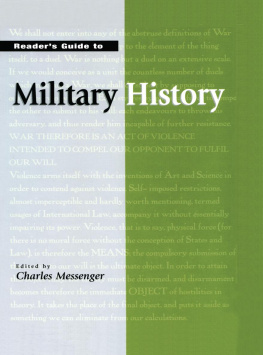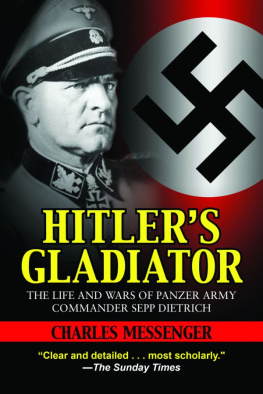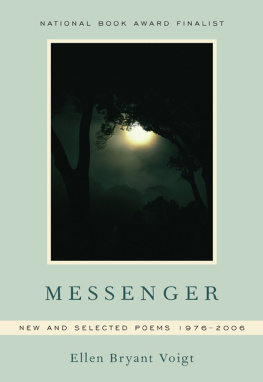First published 2001 by Fitzroy Dearborn Publishers
This edition published 2013 by Routledge
2 Park Square, Milton Park, Abingdon, Oxon, OX14 4RN
711 Third Avenue, New York, NY 10017
Routledge is an imprint of the Taylor & Francis Group, an informa business
Copyright 2001 by
FITZROY DEARBORN PUBLISHERS
All rights reserved including the right of reproduction in whole or in part in any form.
British Library and Library of Congress Cataloguing in Publication Data are available
ISBN 1579582419
Copy editors: Edith Summerhayes and Alyson Lacewing
Proof readers: Fern Bryant and George Pitcher
Index: David Worthington
Cover design: Hybert Design. Cover illustration: extract from On War by Carl von Clausewitz, reproduced thanks to Chris Bassford at www.clausewitz.com
Typeset by Florence Production Ltd, Stoodleigh, Devon
Aims, Scope, and Selection of Entries
Let me start off by stressing that the Readers Guide to Military History is not an encyclopedia. Rather, it is a work of historiography, designed to provide the reader with both the best sources and a summary of the current debates on each of the topics covered.
The entries in the Readers Guide have been selected to reflect the multi-faceted subject that military history has become. Warfare on land, sea, and in the air is covered. While the core remains the numerous conflicts in which humankind has been engaged over the centuries, other entries cover types of warfare, military theory, the dominant military commanders of each period in time, and national armed forces. The growing interest in military sociology is also recognised, as well as such topics as arms control and disarmament. One subject area which has been purposely omitted is military hardware (weapons and equipment), although reference is made to works on this in some of the entries.
We have made every attempt to avoid the pitfall of producing a reference work which is overly focussed on Western European and North American military affairs. For a number of reasons, this has not always been as successful as we would have liked. Many of the worlds major wars have either been fought in Europe or originated there. Consequently, several of the significant developments in the art of war have been European or US based. A notable influence on these developments has been the introduction of new weapons, most of which have owed their birth to Western technology. A further problem concerns the fact that this volume is in English and primarily concentrates on works in that language. The vast majority of citations in the Guide are books in English. There are, however, non-English sources given where those books or journal articles are the best, or sometimes the only, available on the topic under discussion. Indeed there were quite a few non-Western entries on the initial headword list which we would have liked to have included, but lacking any significant English sources, this proved impossible.
Nevertheless, the range of entries is wide. They stretch from the very first attempts at organized warfare among the ancient races of the Middle East to the troubled Balkans and parts of Africa at turn of the 21st century. The entries cover war and conflict in every corner of the globe.
As Editor, I have had the privilege of reading every entry as it has been submitted. The experience has opened my eyes to many aspects of military history of which I previously knew little, but now want to explore further. The only bugbear is time. We hope that you, the reader, will find the Readers Guide to Military History not only a valuable signpost to particular subject areas in which you are interested, but also as a tool for broadening horizons and finding pastures new.
Arrangement of the Entries
The reader will find that there are a number of ways in which the Guide can be approached. The entries themselves are in alphabetical order, but often within broad categories when it comes to major wars. Thus, all the Napoleonic Wars entries appear within one block. In such groups of entries where they share the same general heading, if there is a general works entry, it always precedes more specific subdivision.
While the overall arrangement is alphabetical, there are other aids to facilitate access to the contents of the Guide, These are:
1. Thematic List (p. XXI). This should be consulted to see the full range of entries on a regional, chronological, or general-topic basis. The reader can turn to, e.g. all entries on the Middle East, or all 18th-century entries, or those that deal with general subjects, e.g. media and war.
2. Booklist Index (p. 843). This lists in alphabetical order of author all books and articles discussed in any of the entries, and can be used to locate each time an individual author is cited.
3. General Index (p. 905). This lists individuals, places, peoples, battles, themes and concepts mentioned in any of the entries. This index may be particularly useful for locating subject matters and individuals that do not have an entry of their own.
4. Cross references. At the end of the entries there are See Also notes, which refer the reader to entries on related topics.
Format within Entries
Each entry begins with a list of the books/articles to be discussed. Publication details are provided, including dates of first publication, and, where appropriate, the most recent revised edition. Standard reprints and paperback editions are normally omitted. In the text of each essay, the first significant mention of each author appears in capital letters. In cases where more than one item by the same author is discussed in the same entry, each item is introduced by the authors name in capital letters, followed by date of publication in parenthesis. Although the list of books in each entry is provided in alphabetical order of author, books are normally not discussed in the text in that order. It was left to the judgment of contributors to decide whether to discuss books in order of publication, or more often, according to the subject matter and emphasis of each book. The bibliography included in each entry is by no means exhaustive, but the contributors view of what are the most significant works. They are primarily books in English, but journal articles and foreign language works are cited if the contributor believes that they are essential to understanding the subject and the academic debates that surround it. While the emphasis is on sources published in the recent past and that are therefore reasonably accessible, classic standard works have not been ignored. Indeed the substantial number of recently reprinted editions of older works indicates that the study of traditional military history continues alongside the development of newer areas of investigation such as war and society and ethical/philosophical concerns.
Acknowledgements
The Readers Guide to Military History could not have come into being without the efforts of a significant number of people. First, I must thank the Advisory Board. Not only did they bring their wide-ranging expertise to bear on my original draft lists of entries, ensuring that no significant topic was left out and that a reasonable balance was achieved, but they also recommended contributors and submitted entries themselves. Without the contributors themselves, the














